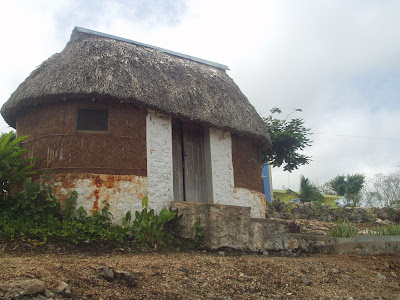 Close up: needs some repair!
Close up: needs some repair!
Chiapas: rainforest calls for wooden walls, screened in.


Hopelchén, Campeche State in the hills.

The American Heritage Dictionary defines a palapa as "An open-sided dwelling with a thatched roof made of dried palm leaves or a structure, such as a bar or restaurant in a tropical resort that is open-sided and thatched with palm leaves. Perhaps from American Spanish, a kind of palm tree."
Wikipedia says the palapa is of Philippine origin and after it was brought to Mexico the people of the region loved them for their heat resistance and the fresh air that flows through. It goes on to say that the palapas were very similar to the indigenous architecture from "western cultures"; what does that mean? I only get Wikipedia in Spanish, so perhaps something was lost in translation.
The most interesting information I could find about the history of palapas was from a company called Wilson Laminate that sells palapas. It states: "some historians believe that palapas have over a 2000 year history in Mexico." What historians? I cannot seem to find any information in the few hours I have been searching the internet. I do believe the construction was used in Mexico for a long long time, and I can believe there was an influence by the Philipinos some time later.
Having lived in Hawaii and traveled through the South Pacific, I can safely say that as unique as the construction of hales, bures, bales, or whatever you want to call these palm-thatched huts can be, there is a similarity that leaves me a little confused. If this were some important link to the history of mankind, I would pursue it to see what the link is. I just happen to like palapas, and will may end up living in one some day...preferably one on the Caribbean coast somewhere. My house and the pool for a palapa en la playa!
Palapa dock near Livingston, Guatemala, Bahía de Amatique.



2 comments:
the word palapa is tagalog for palm frond -the filipinos brought coconut trees form the phils to acapulco thru the galleon trade - the palapa is found everywhere in the islands of the philippines - the filipinos also brought mangoes and a portable distillery to mexico which the mexicans used to make tequlla
palapa is coconut leaves skeleton we used as a firewood or to build nipa house roof
Post a Comment